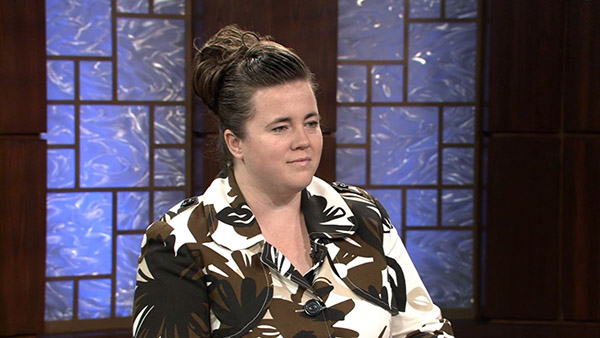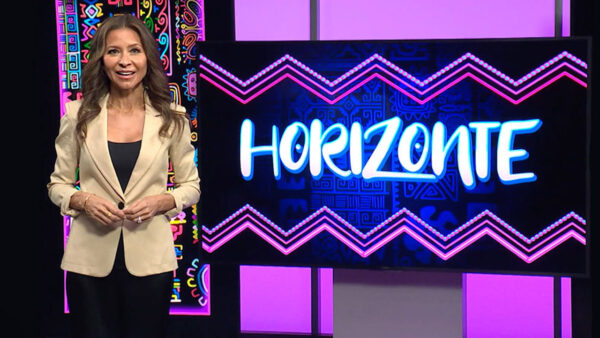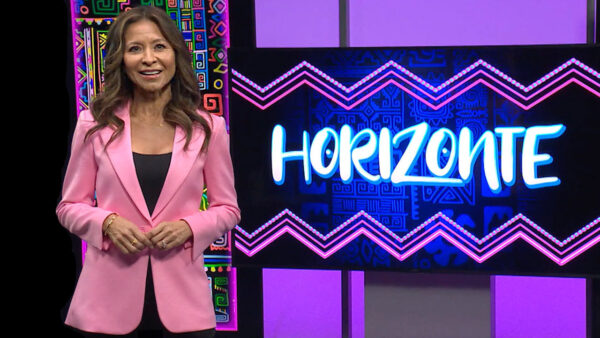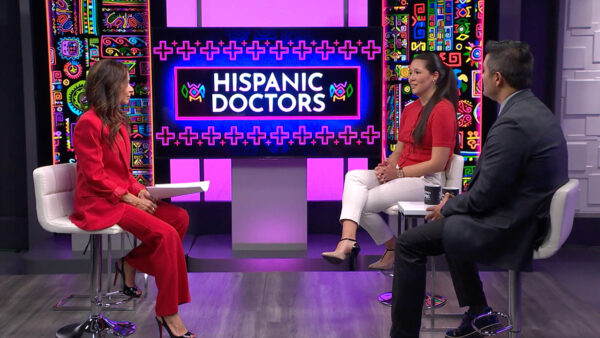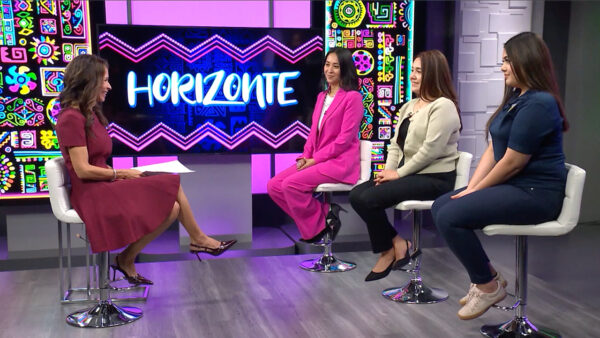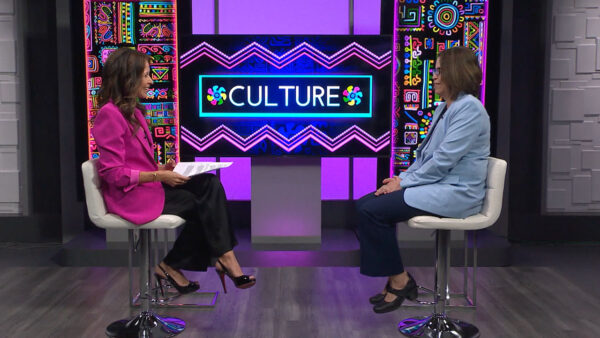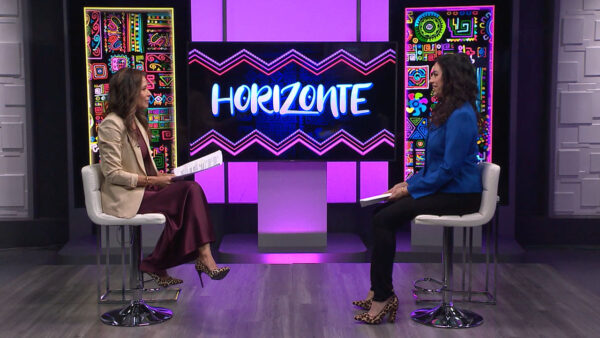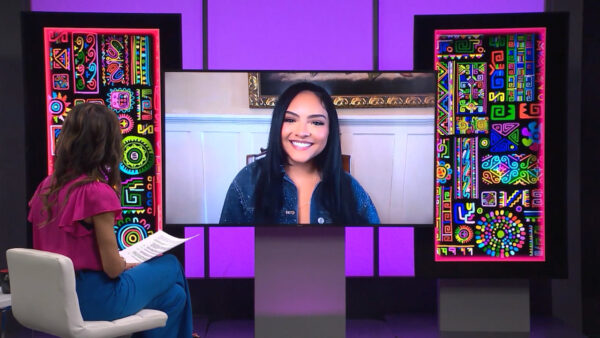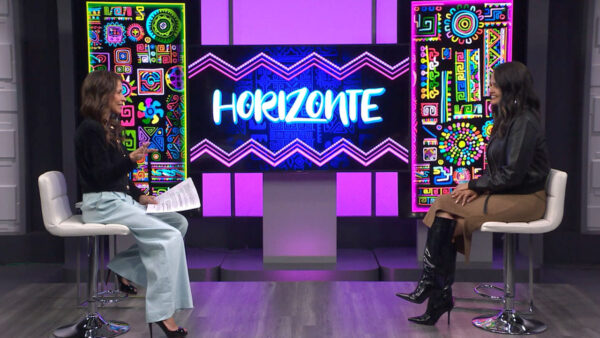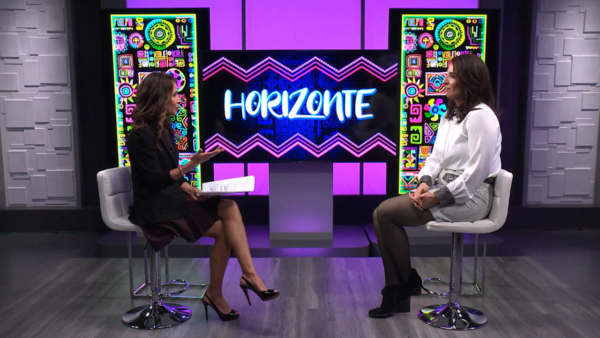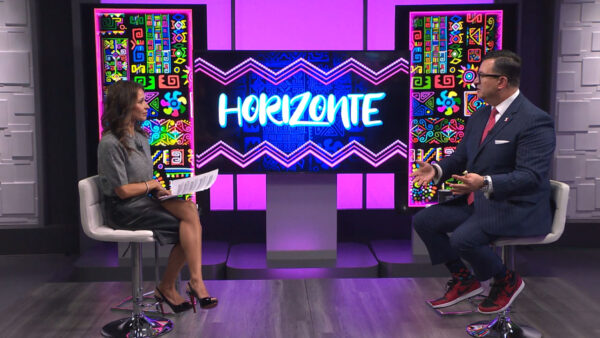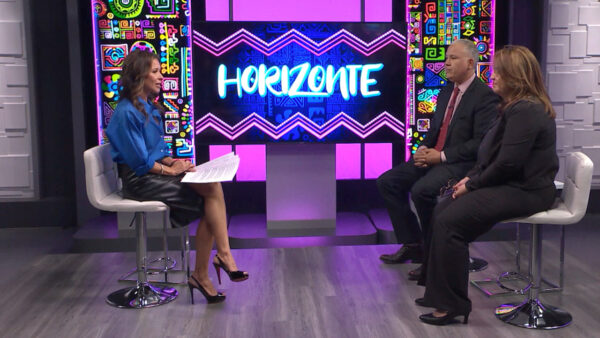Actor Cheech Marin is becoming known in the world of art as the largest private collector of Chicano artwork and paintings. HORIZONTE’s José Càrdenas talks to Los Angeles journalist Oscar Garza and Cheech Marin about Marin’s newest art show, “Papel Chicano: From the Collection of Cheech Marin,” on display in Mesa, and about the reaction and influence Chicano art is making across the country.
Jose Cardenas:
Good evening, I'm José Cardenas. Welcome to a special edition of "Horizonte". Many of you know actor Cheech Marin for his work in the world of entertainment. Now, a unique side of him is also becoming well known across the country, his passion for Chicano art. Tonight, an interview with Cheech Marin -- along with cultural journalist Oscar Garza about Marin's art collection on display right here in the valley. That's coming up next on "Horizonte".
Announcer:
Funding for Horizonte is provided by S.R.P. S.R.P.'s business is water and power. But our dedication to the community doesn't stop there. S.R.P., delivering more than power.
Jose Cardenas:
Actor Cheech Marin is quickly becoming recognized as the largest private collector of Chicano artwork and paintings in the country. Paintings from his collection have been shown on a national tour throughout the country in museums and major cities. Marin's newest art show, "Papel Chicano: Works on Paper from the Collection of Cheech Marin", is now on display at the Mesa Contemporary Arts, Mesa Arts Center. In September, Los Angeles journalist Oscar Garza hosted "A Conversation with Cheech Marin", where Marin talked to people about his art collection and career. I spoke to Cheech Marin and Oscar Garza about the talk, the collection, and the reaction and influence Chicano art is making across the country.
Jose Cardenas:
Gentleman, thanks for joining me on Horizonte. Cheech, last time we were together, we talked about Chicano visions and the exhibition that that was related to. What's the connection between that and Chicano Papel?
Cheech Marin:
Chicano Papel consists of drawings - works on paper, basically. Because I noticed that Chicanos were exceptionally good draftsmen, and drawers and I wanted to feature works that weren't paintings, that were smaller in scale, some of them, but that it shows the breadth of the Chicano artistic talent I had in my collection.
Jose Cardenas:
I said Papel Chicano - it is Papel Chicano as you mentioned earlier. Is that a play off the word of Papel Picato which is the traditional Mexican art form?
Cheech Marin:
It might have been subconsciously. I was just thinking paper ah papel. No, I just thought I'd like to have Spanish in the title. But it was works on paper. That's what drove it.
Jose Cardenas:
Now, Oscar, you were part of the kickoff of the event here at the Mesa Arts Center running through January 6. But there was a special kickoff entitled "A Conversation with Cheech Marin." People in Los Angeles would know you because you're very prominent there in your journalistic efforts. Tell us about your background for the people here.
Oscar Garza:
I am from Texas. I was born and grew up in San Antonio and went to school in Austin and lived in northern California for a little while and moved back to San Antonio and was there for much of the 80's working in first television, actually, and then in newspapers. And then I moved back to California southern California in '89 to work for "The Los Angeles Times". And have been there ever since. I left the Times about two and a half years ago to run a new magazine in Los Angeles called "Ciudad." It's an English language magazine about Latino life and culture in southern California.
Cheech Marin:
It's very good too.
Oscar Garza:
Thank you.
Jose Cardenas:
But before that your focus was also arts and culture.
Oscar Garza:
My newspaper career was spent almost exclusively in cultural journalism.
Jose Cardenas:
Why is that?
Oscar Garza:
You know, it's hard to say. I was always sort of drawn to creative people. And my older brother is an artist. And sort of it's funny you should talk about the ability of Latinos and Chicano artists and how good they are being draftsmen. My brother was, still is a fantastic draftsman. So I grew up watching him and was always intrigued by the creative process and creative people. Just sort of was drawn into that area, ended up being the arts editor at the San Antonio Light which is the Hearst paper at the time and then was the arts editor at the Los Angeles Times before I became editor of the entire arts and entertainment section.
Jose Cardenas:
The Daily Calendar, which received national recognition.
Oscar Garza:
Yes.
Jose Cardenas:
Now, Cheech, in the past you have done things like this. You've kicked off some of these exhibitions with a discussion about your life and the role that arts has played in it. This was different. How did you like the format where you were being interviewed basically?
Cheech Marin:
I love the format much better. Because I was always trying to figure out how to get the show business aspect into it. Because people would come to see me, come to expect that. They want to see or hearing is about show biz but they were interested in arts at the same time. This was a perfect blend between the two that you could weave in and out of both of those subjects really easily.
Jose Cardenas:
And Oscar, I think what Cheech is referring to, we had movie clips, you interviewing Cheech about his life story and then some discussion of some of the pieces in the exhibit. How did you feel about the format?
Oscar Garza:
You know, most of my career has been spent interviewing people in one form or another whether for television or print stories. And I interviewed Cheech one other time, a couple years ago. Do you remember that?
Cheech Marin:
Uhuh. Yeah.
Oscar Garza:
In the California Plaza in Los Angeles. The approach that I take towards -- and I don't know if you noticed it, but I consciously didn't ask him a lot of questions before we met. We met a couple of weeks ago in Los Angeles to talk about the evening what we were going to do here. But I didn't ask him a lot. I like to have a sense of discovery for my own self-when I'm interviewing people. It's a little bit flying by the seat of your pants. But when you're interviewing somebody you know has something to say and you just sort of know where to go and what you want to learn, I guess I'm assuming the audience is going to be interested in the same things I'm interested in. For Cheech, the thing that was really appealing to me about doing this is that people know his career. They know his comedy career and they know his film and television work. I wanted to sort of fill in some holes that I didn't know about, and then also talk about something that nobody has said -- maybe it's been said in other places, but whether by accident or by design he is the pre-eminent collector of Chicano art in the world, I imagine. And that's a huge accomplishment and it says a lot about his commitment to this art forum.
Jose Cardenas:
Cheech, let's talk a little bit about this particular collection. How did you decide which pieces to put into it?
Cheech Marin:
The curators, Pat Haberman from the Mesa Arts Center came down. I had been giving a talk here at the Southwest…something or other.
Jose Cardenas:
Arts conference? That was in January. In Glendale.
Cheech Marin:
Yes. And I had given a talk there. They came up to me and says, would you -- could you do a show here at the Mesa Center? And I go, well, okay. So I thought about it. I thought, you know, I've always wanted to -- I had a lot of pastels in the collection. And I think, pastels and drawings were something Chicanos really excelled at -- Chicanos. I didn't want to travel pastels extensively because they're fragile. And so I said, how about if I do just a couple venues and do pastels? And then from there, it evolved into works on paper. So I just pulled out a bunch of works. Maybe I pulled out maybe about a third of the works that I have on paper. And they were thrilled. And they just curated it from there. They chose the ones that they wanted. Which I was really pleasantly surprised they chose the edgier works.
Jose Cardenas:
Edgier in what sense?
Cheech Marin:
In terms of theme. And more in terms of theme, you know. And they weren't bothered by sexuality or violence or depictions of whatever aspect of Chicano life. They just went to the strongest works.
Jose Cardenas:
I want to come back to that. You touched a little bit on the controversy that greeted the exhibition of Chicano visions. But before we do, that Oscar, you chose the pieces that were highlighted in the conversation last night. How did you do that and why?
Oscar Garza:
I wanted to -- we looked at five different artists, work by five different artists. I just wanted sort of a range of work, some of the masters of the genre, people like Frank Romero, for example, Roberto Guttierez, not as well-known as some of the other bigger names in Los Angeles but that does magnificent work. Patsy Valdez's work, who has -- what's really interesting about Patsy was that early in her career she was involved in very a vaunt guard Chicano group of artists called Osco.
Jose Cardenas:
Osco is Spanish for?
Oscar Garza:
Nausea. They were out there. And in fact to this day I don't think there's anybody did anything quite like them still. They -- speaking of the way that Chicanos were excluded from the art mainstream in Los Angeles, for example, the tax-supported, publicly-funded, county museum in Los Angeles which at one point, up until the [indiscernible] exhibit in the early 70's had never exhibited work by local Mexican American or Chicano artists. Patsy was part of this group, a quartet of artists, including Graug, Harry Gamboa, Willie Aron and -- they basically wanted to make their mark on the county museum. They went down one night and tagged the museum with the name of their group "Osco." Patsy came out of that. It's interesting how she evolved from being in, you know, part of this avante garde experimental group and became a very fine painter with exquisite ability to render her work. Then we showed something by Vincent Valdez, youngest artist in the show, I think he just turned 30, from San Antonio, now living back and forth between L.A. and San Antonio. And again this tradition of somebody who has an amazing ability to draw and render work. And the thing you were talking about, I heard you say or read somewhere where you talked about Chicano artists having to be resourceful and drawing on anything, any kind of material they could get their hands on. The piece that's on the cover of the catalog for the show -- and that's the main piece as you walk into the gallery -- it's done on, is it roofing paper? Yeah. Really like literally roofing paper? And that's the sort of thing where an artist would find whatever he can and the best material to render his work. And it's a stunning piece of art, I think.
Jose Cardenas:
Tell us a little bit about some of the artists featured here. Oscar talked about some of them. Vincent Valdez?
Cheech Marin:
Vincent Valdez is the youngest one. He's from San Antonio. He's just the shooting star of the Chicano art world. He grew up in San Antonio and got a scholarship to Yale to study art there, went there for a year, I believe, didn't like it and didn't like the environment and he transferred to Rhode Island School of Design, which is the avante garde probably number one art school in America, really, having the biggest reputation. There he started plying his Chicano art. It was put down by most of the faculty but there was some faculty that really supported him. They looked at those artists and said, you're never going to be a hit painting these things.
Oscar Garza:
I think on the east coast its still considered folk art at some level.
Cheech Marin:
Yes, folk artist. Folk art. It was the thing you encountered in Hollywood after my experience, Latinos are given no credit for sophistication. They just think they barely speak English and they want to talk slow in front of you. When in fact Latinos come from incredibly sophisticated cultural backgrounds. I mean, they speak two languages and they are heir to a lot of influences from around the world. All these artists went to either art school or university art departments, are university-trained. So they're exposed to all contemporary world art trends as well as art history. And they reference that in their work. So it's like, you know, just like comedians that don't get -- comedians that don't get enough credit for being really the smartest people on the planet. But like for a comedian to -- they say, well, can you do drama? If you can do comedy you can do anything, really. Because it presupposes your knowing what the form is, what the correct part of the form is and then making fun of it.
Jose Cardenas:
Well, and some of the reaction, the negative opposition, comes from surprising quarters. Oscar talked about the Los Angeles county museum of art. As I understand from what you said the other night, they were the last of the major venues to be willing to show Chicano vision.
Cheech Marin:
Yeah. You know, Los Angeles is schizophrenic in that there is an inherent racism in the culture, there has been for a long time in Los Angeles. California elects Ronald Reagan and Schwarzenhegger and they're supposed to be the bastion of liberalism which in fact it is not. They have pockets of it that are highly influential and hog the limelight. But the leadership in the county museum where they were entrenched in what they wanted to do, and they had made up their mind that Chicano art was not art and forget about it. However, they took a third of their budget from the county that is 60% Latino from a city Los Angeles in the State of California.
Jose Cardenas:
Well, Oscar, in the State of Tejas, your old stomping ground, there was another surprising source of opposition to Chicano visions from the Chicano community or Hispanic community that used the word "Chicano."
Oscar Garza:
I think it sort of speaks to sort of regional differences among us. You know, and Cheech was talk about in our talk about how that term in parts of the -- parts of the southwest has a very pejorative meaning still. My parents' generation, Chicano was something they never would refer to themselves as. They were Mexican Americans or -- if you were of Mexican heritage you were a Mexicano. If you were white you were an Americano. Which is weird. It was a very finite way of delineating the differences between them. We were Americans, you know? My father was a decorated World War II hero. Yet they refer to themselves Mexicano, and white people as Americano. Chicano wasn't a term. When it was be absorbed and adopted by the people who were working on behalf of the civil rights movement, and my brothers started using it, it was just something that they weren't thrilled about. And I think some of that still exists in Texas.
Jose Cardenas:
Well, it doesn't surprise, though, it's been 35 years since the Chicano movement seemed to legitimize the use of the word Chicano. Were you surprised there was still that kind of opposition?
Cheech Marin:
I didn't know about the opposition until I started doing this tour and as we started contacting museum. And they said, well, we don't know about the word Chicano. What? I grew up as a Chicano call know. My parents grew up as Chicanos. They called themselves Chicanos, my parents in the 80's. Chicanos were what we were. It was the first time I heard the term that identified me. I wasn't Mexican, "Yo Mexican," I said, I'm not Mexican. I've never been to Mexico. But I knew I wasn't the American of those guys, you know. And when Chicano came around, that's what I am, I'm a Chicano. So that's like the shoe that fits perfectly. It was very comfortable. And I think that it started off as a derogatory term, but I never knew it as a derogatory term until I started researching the history that came along. It involves an attitude. It involves an attitude, it's a defines, a little bit of defiance and a little bit of this is who I am and get used to it. I don't care.
Oscar Garza:
I think also because there had been much more economic progress for Mexican Americans in California than Texas, you know, over the course of time and especially through the 40's, 50's and 60's, the opportunities that were provided by the aerospace industry and the auto industries, I think it just sort of -- there was more the cultural -- trying to think of the right word to use, but it's sort of the progress of what Mexican Americans were able to achieve in California was sort of almost a generation ahead of what was going on in Texas.
Cheech Marin:
It was geographically separated from the border farther. So you have the border states of Texas, Arizona, and especially San Antonio, El Paso, Nogales, that almost represents the tide pools, you know? It's an interface. It's not Mexican and not American but more Mexican than it is traditional Sam Houston, David Bowie you know? That's where change takes place. There's a new creature being born in the swamps. And it's going north.
Jose Cardenas:
You received the Smithsonian Latino Senators Inaugural Legacy award for arts advocacy. What does that mean to you? Does it indicate a particular focus at this point in your career?
Cheech Marin:
It was a great honor to receive the award, especially to stand up on the stage of the Smithsonian, American Indian Museum and watch with all the other guys that I grew up with and worked with. Luis Valdez and El Tigris and -- Duval and a whole bunch of us that were there. And really signaled progress, you know? And just a verification of how far we had come and how far we were now established. And really the progress ahead of us, the journey ahead of us we have to do. We're standing on the precipice of a giant -- precipice of a giant cultural change, numbers. Involved in the largest wave of immigration in history right now, chiefly from Mexico. What distinguishes it is it's in every state of the union, every single state, from North Dakota to Maine to South Carolina to Delaware to you name it. There's big Latino populations in every one of those states. And they're all going to come of age socially, politically, economically, at once. And it's going to be a big change for America. Salsa is the number one condiment over catsup right now. The change is already occurring. We're just getting used to the fact.
Jose Cardenas:
Oscar, you've covered the arts scene for nearly 20 years as a journalist. What's your assessment of the progression?
Oscar Garza:
It's funny. Because at some levels there have been astounding sort of achievements made. And yet at other levels, you wonder why things haven't quite happened yet or quickly enough yet. Los Angeles, for example, for all the talent that exists there for the huge just sheer numbers of the Latino population there, to this day Los Angeles does not have a major Latino cultural arts center. When I say major, I mean something that's sort of huge, not only huge edifice but that has sort of the vision of representing, you know, cultural achievement from our people. They're finally now, ironically, or there are two efforts finally in Los Angeles, one being supported by the county, downtown Los Angeles, that is being -- it will be a couple of years away still before they open, and then there's also a Latino museum of history, art and culture, that is now sort of also part of the theater rebirth in downtown Los Angeles at the Los Angeles Theater Center. And so I think the other thing that's happening, you know, is that main street art centers around the country -- and I think Cheech can speak to this probably better in terms of reaction that they got when touring the Chicano vision show, I think again maybe a little slower than we would have liked. But the mainstream art institutions are sort of opening up a little bit more to this work, to the culture. And the smarter ones are realizing what Cheech was talking about, which is that this is the future, you know? These are going to be their future patrons and people who visit the museum, you know. It happens when people come to this country, when Latinos come to this country, whether from Mexico or other places in Central America, you know, they come here and their kids, their kids speak English, you know? It happens very quickly. And once their kids start speaking English they become part of this large, huge population of truly, truly, truly bilingual, bicultural population. Kids who really, like us, spent our lives going back and forth between two cultures. Every day, alternating from hour to hour, minute to minute where you step back and forth in these worlds. That's not just happening now in the southwest. It's literally happening in every state in this country. And with that, of course, comes tension and issues and problems. But as Cheech said, you know, these people are going to keep coming. This is just the reality of where we are. I don't think there's any law that's going to change that.
Jose Cardenas:
Cheech, I want to close with something that may impact that future. And I know you certainly hope it will and something that's important to you. And that's the scholarship fund that you're involved in. Tell us about that.
Cheech Marin:
Over the years I had been hit up by a number of agencies to lend my efforts or energies to getting kind of charitable, Latino-based organizations. And I decided to center my activities on one that would do the most good. And I chose the Hispanic Scholarship Fund as the number one scholarship fund for Latinos in the United States. And I put all my efforts there, because I think education is absolutely the [indiscernible] of cultural and financial and every other advancement. And so their mission has been to put as many Chicanos or Latinos in college as possible. As I've helped them raise money. As an adjunct of the Chicano vision show had a print series done, 115 sets of these archival, g-plate prints of the show. And of 20 sets of those have been sold for the benefit H.S.F. they started a scholarship in my name, which was the first post graduate scholarship in H.S.F. history. Because I thought, okay. We've got enough fertilizer. It's time to grow some real prized specimens here, you know? I looked at the Rhodes Scholarship or Full Bright or those that are endowed by a large endowment. I would like to start building up that fund there so that our post graduate Latino students can study anywhere in the world. Because they are world-class artists and scholars. And so to kind of further that, it's time to do that. It's past time to do that.
Jose Cardenas:
Well, and Chief Marin, thank you for that. Cheech Marin, thank you for bringing Papel Chicano to Arizona. Oscar, thanks for kicking it off in a marvelous way. Thanks for joining us on Horizonte.
Jose Cardenas:
Papel Chicano from the collection of Cheech Marin is on display at the Mesa Contemporary Arts Mesa Arts Center -- now until January 6. Thank you for joining us for this special edition of Horizonte. I'm Jose Cardenas. For all of us here at Horizonte, have a good evening.
Announcer:
If you have questions or comments about Horizonte, please write to the addresses on your screen. Your comments may be used on a future edition of Horizonte. Funding for Horizonte is provided by S.R.P.
Announcer:
S.R.P.'s business is water and power, but our dedication to the community doesn't stop there. S.R.P., delivering more than power.
Cheech Marin: Actor, author, art collector;
